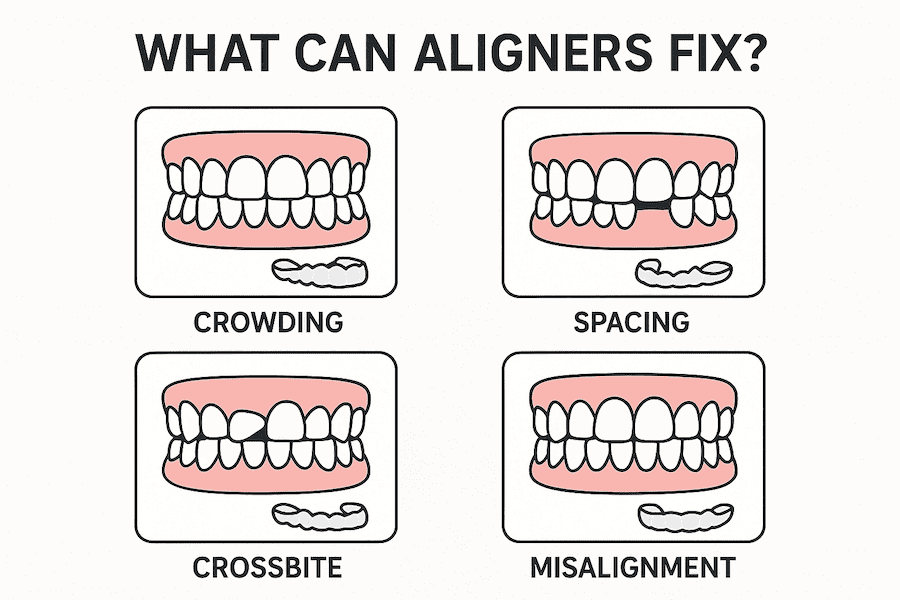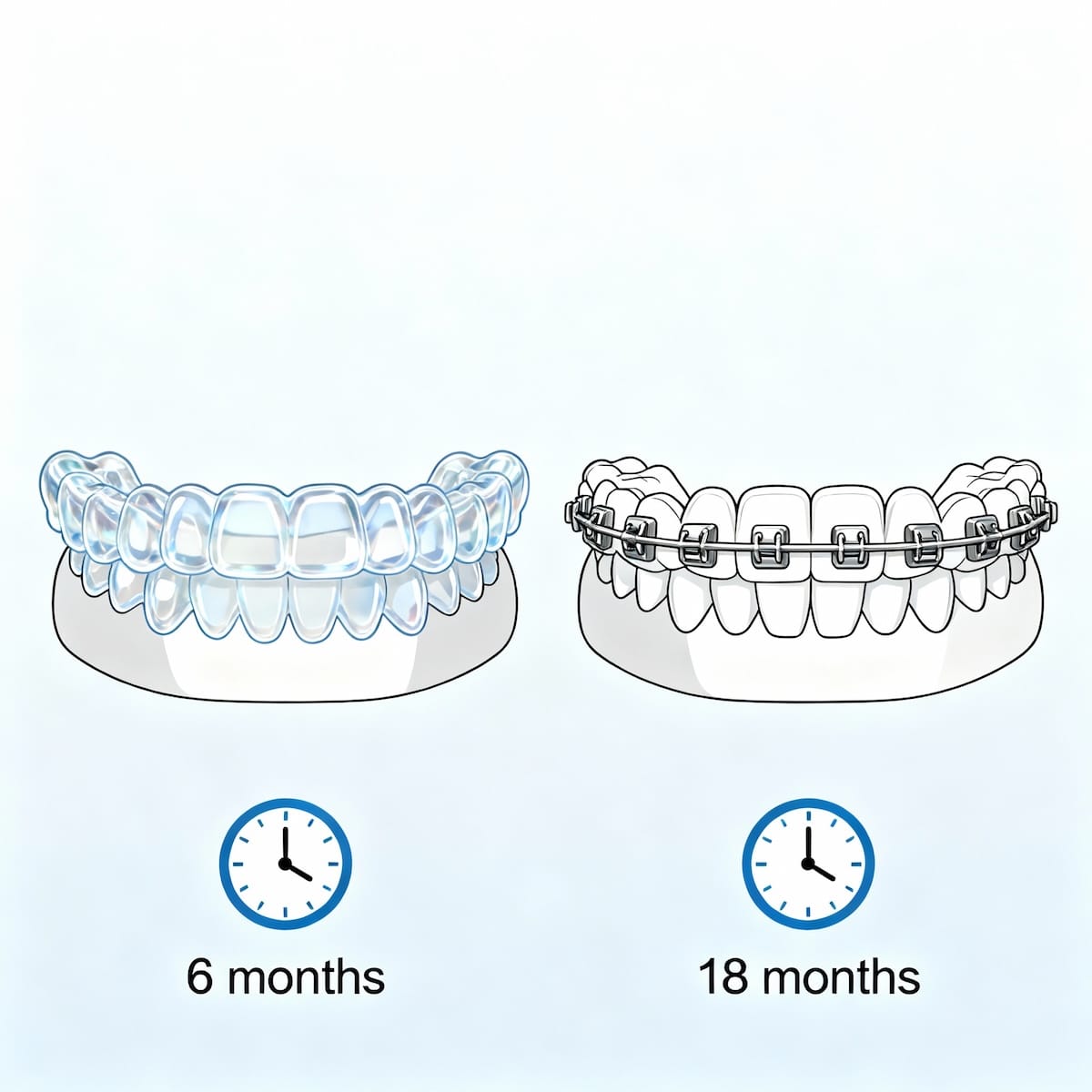Do Aligners Really Work? Effectiveness & Results Explained
In the past few years, there has been a wave of change in the way people approach dental care. From urban millennials to working professionals, more and more people are ditching traditional braces and opting for clear aligners. Their growing popularity is no surprise as aligners are comfortable, nearly invisible, and fit seamlessly into modern lifestyles.
But the big question remains: do aligners really work? Are they just a cosmetic fad, or can they actually transform your smile? Today, we’re here to answer every possible question you may have about aligners.
What are Dental Aligners?
Dental aligners are clear, removable trays that sit snugly on your teeth and slowly move them into a better position. They are made using digital 3D scans of your mouth, so each set is customised just for you. Because they’re almost invisible, many people also call them clear or invisible aligners.
Unlike braces that use metal wires and brackets, which are visible from afar, aligners are smooth, comfortable, and hardly noticeable. That’s why they’re a popular choice among students, young professionals, and anyone who wants to straighten their teeth without drawing attention.
Do Aligners Really Work?
Yes, aligners really work by using a series of custom-made, clear trays that apply gentle and consistent pressure to gradually move teeth into their ideal position. They’re most effective for mild to moderate dental issues like crowding, gaps, and minor bite problems. For best results, aligners should be worn for 20–22 hours a day. However, severe misalignments or complex bite corrections may still require traditional braces for more precise results.
For the best results, aligners must be worn consistently for 20 to 22 hours a day, and success depends on patient compliance and good oral hygiene. Consulting an orthodontist is the best way to determine if aligners are the right treatment for your specific needs.
Here are some things to consider when thinking of going for aligners:
- Best for mild-to-moderate cases: A study published in PubMed Central confirmed that clear aligners are effective for treating mild to moderate anterior open-bite correction in adults.
- Wearing discipline matters: Aligners must be worn 20 to 22 hours a day for results to show. If you’re consistent, you’ll see steady improvement; if not, treatment time may extend.
- Not for severe cases: If you have severe misalignment, complex bite problems, or jaw issues, braces or other orthodontic treatments may be recommended.
- Patient compliance = results: Ultimately, the success of invisible aligners depends less on the product itself and more on how committed you are. With proper wear and regular follow-ups, aligners absolutely deliver.
At Dezy, advanced AI-driven scans ensure that each patient’s aligners are designed with precision. This means treatment plans are predictable, and you know exactly what to expect from day one.
Find Out if Aligners Are Right for You?
Book Your Free Consultation Today!What Can Aligners Fix?

Clear aligners are designed to correct a range of dental issues, particularly mild to moderate cases of not only alignment issues but also bite functions and overall oral health. Conditions such as crowding, gaps between teeth, and minor bite problems, including overbites, underbites, crossbites, and open bites, can often be effectively treated with aligners.
Here’s a quick overview of dental issues they can fix:
- Mild to Moderate Crowding: If your teeth are overlapping or slightly rotated, aligners can gradually reposition them.
- Gaps or Spacing: Aligners gently close spaces between teeth, helping you achieve a more uniform smile.
- Minor Bite Issues: Problems like mild overbite, underbite, or crossbite can be treated effectively.
- Crooked or Tilted Teeth:Slightly angled teeth can be guided into proper alignment.
- Relapse Cases: If your teeth shifted after braces (a common issue that happens when you don’t wear retainers), aligners can fix that too.
How Do Aligners Work?
Aligners work by applying gentle but direct pressure on your teeth through the custom-made clear trays. This pressure gradually shifts teeth to their desired position. The entire process, right from the creation of the trays to the switching stage, is fascinating and here’s how it works:
- Digital Scan or Impression: A 3D scan of your teeth is taken, which creates a precise digital model of your teeth, forming the foundation for your entire treatment plan.
- Custom Treatment Plan: Using advanced software, your orthodontist maps out exactly how your teeth will move, stage by stage. This digital plan predicts the final outcome and ensures that each aligner tray is designed to move your teeth in small, controlled increments.
- Series of Trays: Based on the digital plan, multiple sets of custom aligner trays are created. Each tray is slightly different from the previous one, representing the next stage of tooth movement. Wearing them in sequence ensures your teeth gradually shift toward the desired position.
- Tray Switch: Every 1 to 2 weeks, you swap your current aligner for the next set in the series. This step-by-step progression keeps your treatment consistent and on track, while allowing your teeth to adjust comfortably to each new position.
- Gradual Progress: Each tray is designed to apply gentle, precise pressure on specific teeth, guiding them safely and efficiently into place. Over time, this continuous, controlled movement gradually reshapes your smile, improving alignment, bite function, and overall oral health.
You can read this post to learn more about how aligners works.
See How Aligners Can Transform Your Smile
Book a Free Consultation Today!Do Aligners Work Faster Than Braces?

Yes, aligners can work faster than braces, but it depends on your adherence to the treatment and the complexity of your case. In some cases, traditional metal braces have been shown to give faster results due to the continuous pressure applied. But this doesn’t necessarily hold true for everyone.
- Average Timeline: For most patients, aligners work within 6 to 18 months.
- Braces vs Aligners: Braces may be slightly faster for very complex cases, but for mild-to-moderate corrections, aligners are equally effective.
- Discipline = Speed: If you wear aligners consistently, you may even finish treatment faster than with braces.
Real Results & Success Stories
Nothing builds confidence like real stories from people who’ve been through the journey. At Dezy, we’ve helped thousands transform their smiles with aligners. Don’t just take our word for it, see how aligners have changed real smiles with Dezy:
- Raahath, came for treating protruding teeth: "After years of hiding my smile, I chose to get aligners, and six months into the treatment, I’m already receiving compliments and seeing a noticeable improvement in my teeth."
https://www.youtube.com/watch?v=4vKfI9I-Ptw - Aardra, came for treating misaligned teeth: "I decided to go with aligners because they’re a painless and invisible way to fix my teeth. Just five months in, my smile has already improved, and I feel far more confident."
https://www.youtube.com/watch?v=0ilsHat4-PA - Sini, came for treating crowded teeth: "With crowded teeth, braces weren’t an option for me, so I chose to go for aligners with Dezy. After three months, they’re almost invisible at work, and I can already see my smile improving."
https://www.youtube.com/shorts/wZVieFs-QqA
Conclusion
So, do aligners really work? Absolutely! When used correctly and under expert supervision, they are an excellent choice for mild-to-moderate dental corrections, offering comfort, flexibility, and aesthetics all in one.
With India’s growing demand for modern dental care, Dezy makes aligner treatment accessible, affordable, and predictable, backed by technology and orthodontic expertise.
Find Out if Clear Aligners Are Right for Your Smile With Dezy’s Experts.
Book Your Free Consultation Today!FAQs
1. Do clear aligners work?
Yes, invisible aligners work effectively for mild-to-moderate dental issues. They are discreet, comfortable, and can deliver great results if worn properly.
2. What dental problems can aligners not fix?
Aligners are not ideal for severe cases like major bite corrections, complex rotations, or skeletal jaw issues. In such cases, braces or surgery may be required.
3. Do aligners really work for crooked teeth?
Yes, as long as the crookedness is mild to moderate. For severely rotated teeth, braces may be more effective.
4. Do clear aligners work for overbite?
Yes, they will work for minor to moderate overbites. If there are any other severe complications, you may need additional orthodontic intervention.
5. Do invisible aligners work for an underbite?
Mild underbites can be corrected with aligners. Complex underbites, however, often need braces or surgery.
6. Do aligners work permanently?
Yes, provided you wear your retainers after treatment, as they are essential to maintain your new smile.
7. Do aligners work better than braces?
No orthodontic treatment is ever universally “better” than the other. This is because each patient has a different complexity and a preference for treatment. But if you want a more subtle treatment option and have mild-to-moderate dental issues, aligners are effective as braces and are more comfortable. For more severe cases, however, braces are the better choice.
8. Do aligners work without braces?
Yes. Aligners are an independent orthodontic treatment, designed to work without braces.

